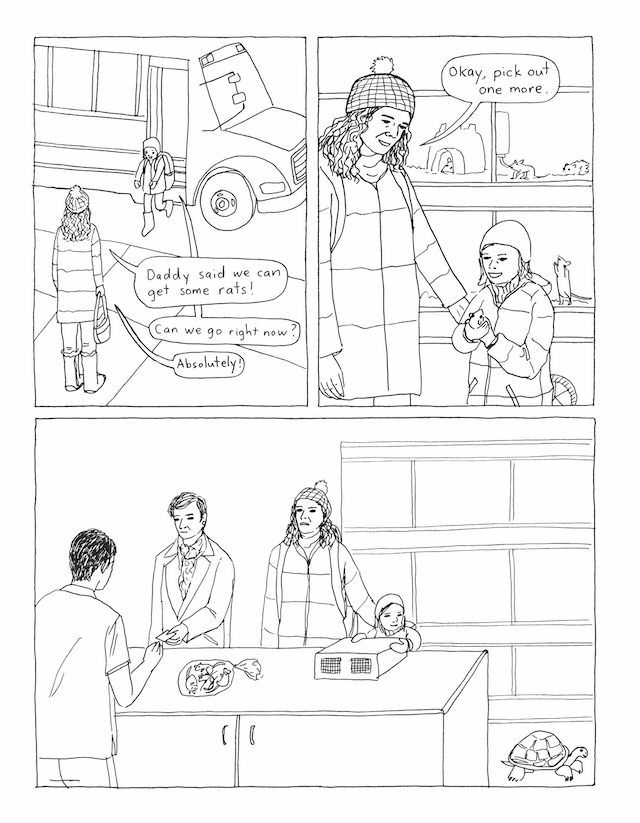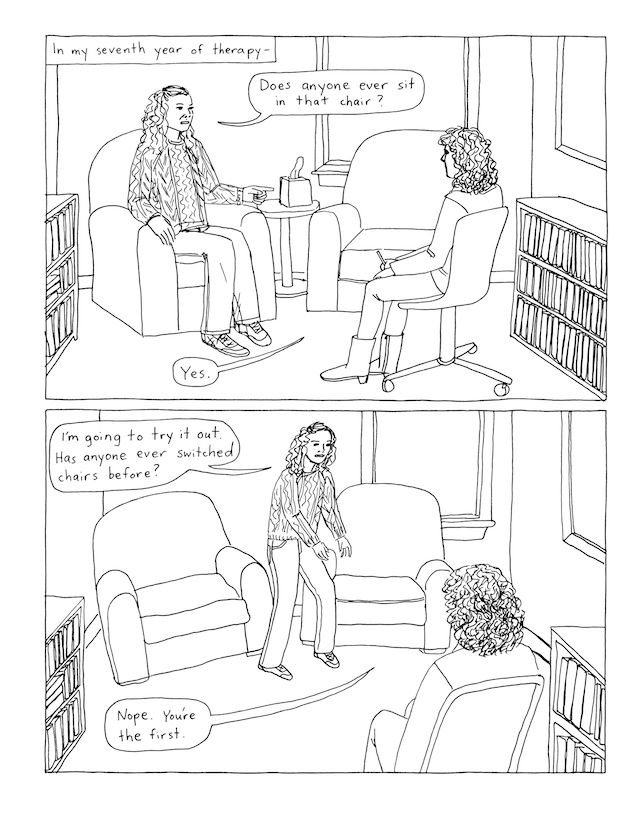Fans of the Ignatz award-winning comic artist Keiler Roberts will not be disappointed by her latest autobiographical work, Rat Time. As in her other five books, the artist serves up a series of entertaining slice-of-life vignettes about the daily life of her family of three. Unlike her previous collection Chlorine Gardens, which addressed important milestones in Roberts’ life, Rat Time focuses on lighter subjects, such as pets, mementos, teaching and school moments, the author’s love of dolls, and some hilarious home mishaps. But there is an underlying tension throughout this volume—the struggle of someone coming to terms with serious health issues while juggling multiple family and work-related responsibilities. Nevertheless, readers will still enjoy Roberts’ deadpan humor and wry wit mixed with a few poignant moments.
It will come as no surprise to the cartoonist's fans that the animal-loving Roberts family has adopted a pair of rats, Mateo and Sammy. After dinner at the Roberts’ home has become “rat time” when Roberts and her daughter Xia play with their new pets. For Roberts, rat time is a type of alternative medicine. With new pets to love, she has something to feel optimistic about. It’s a way to forget about her recent multiple sclerosis diagnosis. When one of the rats dies, he is quickly replaced. Then the other dies, an untimely but slightly humorous reminder of illness and death that Roberts wants so much to avoid. The artist skips back in time to burying a beloved hamster under the outside doormat of her childhood home. But digging up the frozen earth proves too difficult, so her recently departed pet is only partially buried, leaving a conspicuous lump under the doormat, which is stepped on repeatedly by people coming and going. The humor turns darker when Xia informs her mother that the initial of Mateo and Sammy is “Ms.” like her teacher “Ms. Perkins.” Roberts then realizes that the initials also stand for multiple sclerosis.
 Although the comic artist lets readers into her life, she is not one to overshare. Her husband is a regular character, but little about their personal relationship is ever disclosed. The same can be said about Roberts’ avowed bipolar diagnosis. While she does a funny series about the things that make her cry (including nothing at all) followed by a visit to her psychologist, she sheds little light on her struggles with the disorder. In a vignette, she describes her hypomania to a counsellor as a time when she feels safe and content, which is at odds with what immediately comes to mind when most of us think of any type of mania. Roberts presents her universe in understated terms, devoid of high emotion. The comic artist moves seamlessly from one topic to another in much the same way as a conversation unfolds between two close friends, with tangents and natural segues between topics. Understatement also characterizes her approach to her art. She uses very simple thin lines and convincing proportions. Her drawings are at times ungainly, but still appealing, and she offers just enough realistic detail to draw the reader into the moment. This pared-down aesthetic appears to be an intentional choice rather than a lack of skill, as the reader sees in Roberts’ portrait of her dog Crooky, which is by far the most elaborate drawing in the entire volume.
Although the comic artist lets readers into her life, she is not one to overshare. Her husband is a regular character, but little about their personal relationship is ever disclosed. The same can be said about Roberts’ avowed bipolar diagnosis. While she does a funny series about the things that make her cry (including nothing at all) followed by a visit to her psychologist, she sheds little light on her struggles with the disorder. In a vignette, she describes her hypomania to a counsellor as a time when she feels safe and content, which is at odds with what immediately comes to mind when most of us think of any type of mania. Roberts presents her universe in understated terms, devoid of high emotion. The comic artist moves seamlessly from one topic to another in much the same way as a conversation unfolds between two close friends, with tangents and natural segues between topics. Understatement also characterizes her approach to her art. She uses very simple thin lines and convincing proportions. Her drawings are at times ungainly, but still appealing, and she offers just enough realistic detail to draw the reader into the moment. This pared-down aesthetic appears to be an intentional choice rather than a lack of skill, as the reader sees in Roberts’ portrait of her dog Crooky, which is by far the most elaborate drawing in the entire volume.
 In Rat Time, the comic artist reveals that she would like to write fiction. However, her character ends up looking a lot like her, "only with boobs". Later in the series, she creates an exchange between two Barbies but then laments that her fictional storylines always end up autobiographical. Fiction might be too artificial a construct for Roberts, who approaches her work with such honesty. She brings to light funny, ironic moments of everyday life that most of us overlook. The magic of her work is just how relatable those moments are, without any plotting or drama—two important components of fiction. Not only would her approach, wit and material not be as enjoyable written as fiction, but readers would also not have that immediate access to her world through her art. Ultimately, Roberts’ work is best suited to right where it is: comics.
In Rat Time, the comic artist reveals that she would like to write fiction. However, her character ends up looking a lot like her, "only with boobs". Later in the series, she creates an exchange between two Barbies but then laments that her fictional storylines always end up autobiographical. Fiction might be too artificial a construct for Roberts, who approaches her work with such honesty. She brings to light funny, ironic moments of everyday life that most of us overlook. The magic of her work is just how relatable those moments are, without any plotting or drama—two important components of fiction. Not only would her approach, wit and material not be as enjoyable written as fiction, but readers would also not have that immediate access to her world through her art. Ultimately, Roberts’ work is best suited to right where it is: comics.







